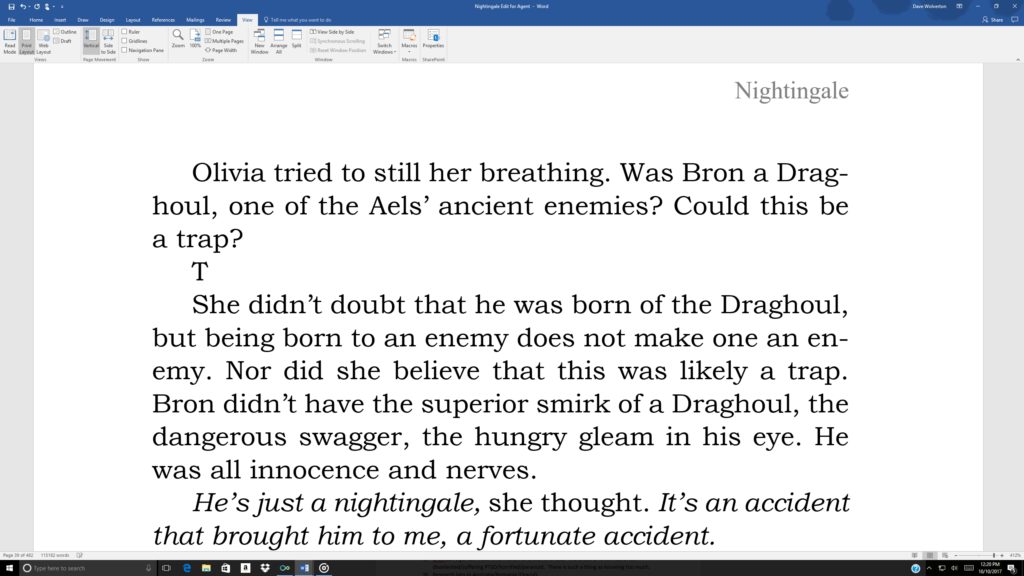In the writing profession, the term word has a special meaning that most new writers don’t understand.
If you see the word I and the word anaphylactic on paper, they’re both words, right? Each is one word.
But not if you’re a professional writer. Years ago, when typesetters were trying to figure out how long a manuscript was, they had to develop a very precise way of calculating length. After all, it was tough to take hundreds of thousands of pieces of lead type, hook them all together, and create a book. They needed to know how many characters and blank spaces they would be using. Remember that: blank spaces.
So they created a definition for a word: six character spaces.
Now, among typesetters, six character spaces could be letters, numbers, punctuation marks, or just plain blanks. In the following sentences, I have some of each: “John, there are 4,324 jellybeans in the jar exactly—I saw it in a dream—and if you guess right, you’ll win the big prize!” Now, if I indent that as part of a new sentence, there will be five character spaces in front of the indented word, and so those all add to the “word count.” There may be dozens more blank spaces at the end of the paragraph, and those will all add to the word count, too.
So how many words are there in the word “I”? Well, there is going to be the letter I and a blank space. So that’s one third of a word. And how many words are there in “anaphylactic”? There are eleven characters and one space after it, so that gives us exactly two words, as professionals in our field measure it.
Why is this important? A lot of new writers try to rely upon their computers to give them a word count on their documents. But computers measure it wrong. The computer typically measures each time that you hit the spacebar, and it never measures blank spaces. Because of this, the computer typically gives a word count that is about 30 percent too low.
In other words, if you have a publisher who says that they won’t take a novel over 100,000 words, and you send one in with a word count of exactly 100,000 words, you’ll probably be sending in a manuscript of about 130,000 words, as the professionals count them. You may be trying very hard to meet the publisher’s requirements, and failing.
This happens to me all of the time in Writers of the Future. I get a lot of authors who know that the stories have to be under 17,000 words, and so they send me manuscripts that are exactly 16,999 words, as the computer measures them. But the official word count will actually be something closer to 22,000 words.
Now, as an editor, I try to be a nice guy. I want to accept such stories, but technically they are over the limit. So I tend to judge them a bit more harshly than a story that is well under my upper limit.
I suspect that other editors at major publishers feel much the same. In fact, I know that some of them enforce a word limit very strictly.
So, how do you know what a word is? It’s easy. Set your margins on your writing file to: Top 1.5 inches, bottom 1 inch, left 1 inch, right 1.5 inches.
Then set your font to Courier 12 point.
Set your line spacing to exactly 24 points of space between each line.
Then set your tab so that with each paragraph you indent the first line a ½ inch.
If you do this, you will have exactly 1500 characters per page, or 250 words per page. Thus, if your story is 20 pages long, you’ll have a 5000 word story.
It’s very important for you as a writer to be sure to measure your stories properly. If you’re writing a short story or an article and you’re getting paid by the word, you wouldn’t want your editor to short you, would you? You wouldn’t want to labor to write a 5000-word story, only to have him pay you for only 3500 words.
Well, the truth is that authors let themselves get shorted all of the time. Many magazine editors count on it. They want to pay you less. So they’re happy to take the word count from your computer, and many new authors feel so lucky to be in print that they just take it.
So we have standards. When you write a novel or a short story, do yourself a favor: Learn to put the proper word count on it! It shows editors that you understand your own business, reduces headaches, and it makes you more money.
***
Hellbounce by Matt Harrill – David’s friend, Matt Harrill, has his novel up for free this week on kindle.
As a prison psychologist, Dr. Eva Ross has always dealt with her share of sinners. But when her boss, the brilliant and unorthodox Gideon Homes, begins to make questionable decisions, Eva’s life changes. Between the trials at work and her loveless marriage, Eva is forced out of the life she knows.
After she encounters Madden Scott, a drifter with irascible charm, it quickly becomes clear that all is not what it seems. As everything around her crumbles into a new reality, the secrets that were barely hidden under the surface become a reality.
Their adventure takes them through nightmares and across continents, as they are thrust into the shadowy realm that separates our world… and what lies beneath.








